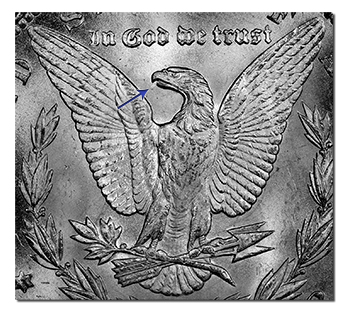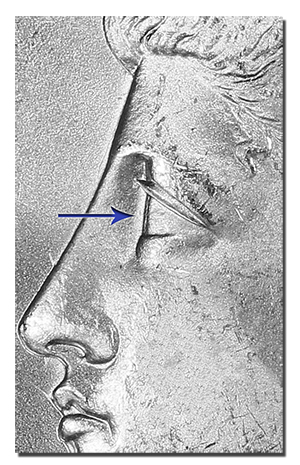
Morgan Dollar Varieties By Ron Drzewucki – Modern Coin Wholesale ….
Outside of a “Bugs Bunny” Franklin half dollar, it’s hard to beat some of the colorful names attributed to Morgan Dollar Varieties over the years. I don’t often write about them, so to “fill in the gaps” and maybe introduce people to one of the more fascinating aspects of the Morgan series, I decided to write about three of the most amusingly named Morgan varieties out there: the “Spitting Eagle”, the “Alligator Eyes” and the “Donkey Tail”.
They happen to share a theme so I chose those three instead of, say, the 1888-O “Hot Lips” Morgan Dollar Varieties, which, hands down, wins at humorous nicknames and is probably the most well-known of the four. Animals are entertaining, and I didn’t want to get stuck trying to whip up a primer on Morgan Dollar Varieties and variety collecting (though I will explain some technical terms you may be unfamiliar with).
One thing you might notice about the three Morgan Dollar Varieties I’ve chosen is that none of them are in the Red Book. Whitman Publishing and editor Kenneth Bressett have to be judicious about which coin varieties they include. Otherwise the Red Book would be a giant book of varieties – of little practical use to many collectors (especially beginners) and unfair to the collectors of varieties that somehow still didn’t make the cut.
For their part, Morgan dollar varieties are discussed in the works of Leroy Van Allen and George Mallis (originators of the VAM variety cataloging system), and Michael Fey and Jeff Oxman (the “Top 100” guys).
The 1891-CC “Spitting Eagle”

The Spitting Eagle is an example of a Mint error known as a “die gouge”. A die gouge is when something or someone accidentally makes a hole or gash (deeper than a scratch) in the die. Since the die is incuse (engraved or imprinted in negative relief into the surface, the opposite of a coin), this hole or gash shows up as a bump or raised mark on the finished product. At first glance, it can even look like a strange part of the design.
Well, that’s what happened at the Carson City Mint in 1891, producing this variety of Morgan silver dollar.
A Spitting Eagle is identified by the glob under and to the left of the eagle’s open beak on the reverse. It does indeed look like a “spitting” eagle. It’s not as prominent as the coin’s design itself, but it’s very obvious on nice examples.
I’d expect to pay anywhere from $500 – $600 for the better material but don’t let that deter you. This is one variety that’s easy to explain and show off so go ahead and buy that Very Fine or About Uncirculated Spitting Eagle. You might be the hit of the next coin club show and tell.
But if you like complicated, the Spitting Eagle has several subvarieties, mostly involving die doubling (when the die strikes a coin a second time slightly off-center from the previous strike, resulting in the appearance of a second image underneath part or all of the main design) and different die pairs (a lot of dies are used to produce a coin’s mintage, and some of them have idiosyncratic characteristics that numismatists can identify or hypothesize about).
The 1887-P “Alligator Eye”

And speaking of die doubling, the next zoomorphic Morgan Dollar Varieties on my list is an intriguing example. While the doubling itself is subtle, the effect is striking.
Part of the beauty of George Morgan’s portrait of Miss Liberty is the size and clarity of her facial features. Her eye, nose, lips, prominent chin and beautiful cheek are uncommonly large for an American coin. This alone should convince anyone that Morgan knew how to use the space on a coin to good effect. But I’ve raptured on about that before.
There is, however, a downside. Take any circulated Morgan dollar; how nicked and scratched is Miss Liberty’s face? Beauty is fragile and fleeting, but die doubling lasts forever.
The same large features and empty space that can make it so hard to find nice circulated business-strike Morgans also allow us to see a wider range of die errors at smaller scales than might otherwise be possible on another coin. Hence, the “Alligator Eye” 1887-P Morgan dollar variety.
Basically, the Alligator Eye is die doubled in such a way that a secondary image (or line) is visible in the front of her eye. Since it’s a vertical line, this has the cool effect of making her look like something out of a David Icke reptilian conspiracy theory YouTube video. It’ll definitely bring a smile to your face when you see one.
Mint State examples are actually quite affordable, with 63s and 64s going for less than $100 apiece, and 65s going for between $100 and $200.
The 1887-P “Donkey Tail”
It’s interesting how many different ways there are to make a lump on a coin.
I already mentioned how the Spitting Eagle variety came into existence as the result of die gouging. Well, the “lump” on the Donkey Tail Morgan, while it’s in a different place, looks a lot like the one on the Spitting Eagle. This time, though, the effect is due to something called a “die break”.
A die break isn’t quite what it sounds like, because a truly broken die would be removed from service and any coins made with it would never leave the Mint. When a numismatist says “die break”, they’re referring to a crack on the die–it’s on its way out, but the Mint can probably squeeze another few mintings out of it for economy’s sake.
How does it happen? Remember, coins are made of metal, so anything that has to hit that metal at brutal speeds, over and over and over again–even if it is made of metal itself–is going to succumb to wear eventually. Die cracks are found on coins minted from older dies or newer dies of inferior quality.

1887-P VAM-1A “Donkey Tail”. Note die damage along the bottom of DOLLAR and pronounced cud under the “D”.
Anyway, the “Donkey tail” Morgan Dollar Varieties in question is an elegant little lump at the base of the “D” in DOLLAR on the reverse. You often see a jagged line that looks very much like a crack underlining the inscription, as well.
Unfortunately, the Donkey Tail can be expensive. Extremely Fine and About Uncirculated pieces can go for several hundred dollars. Which I can understand. The die break is fortuitously well-placed and looks intentionally decorative; it sort of reminds me of the Dairy Queen logo. Or some secret, ancient letter dropped from the alphabet long ago for obscure reasons that still pops up mysteriously from time to time.
Is it the reptilians? I’ll dig through the underbelly of Morgan Dollar Varieties and find out!
Stay tuned.
-Ron





I have a morgan silver dollar from 1891 new orlands would like to know wjat is it eorth and how can i sale it
You can find out your coins values from, The(holy)Red Book. Also, for a month to month value check out the, Grey Sheet, and Google! But the coins numismatic grade should ruffly know so consult a local gold and coin shop, but tell them first off you aren’t going to sell them, cause they might give you a low ball grade.
I have 2 Morgan silver dollar 1885 and 1886 the spitting eagle how much are they worth and how can or where can I sell them.
Refer to comment above. Knowing the estimate of your coins grade is key to selling them. And if your coins are mint State it may be worth submitting your coins to either PCGS or NGC. They are trusted and The Who who of professional grading. A graded coin documents thee exact grade so selling is easier and profits can possibly be made.
Hi do u have info on this or is it a fake I have what looks and seems like a 1900 Morgan dollar but it face is to the right and not to the left
I have a what looks to be a 1921 Morgan silver dollar. But the last two numbers of the date are not legible. Looks doubled to. Any ideas?